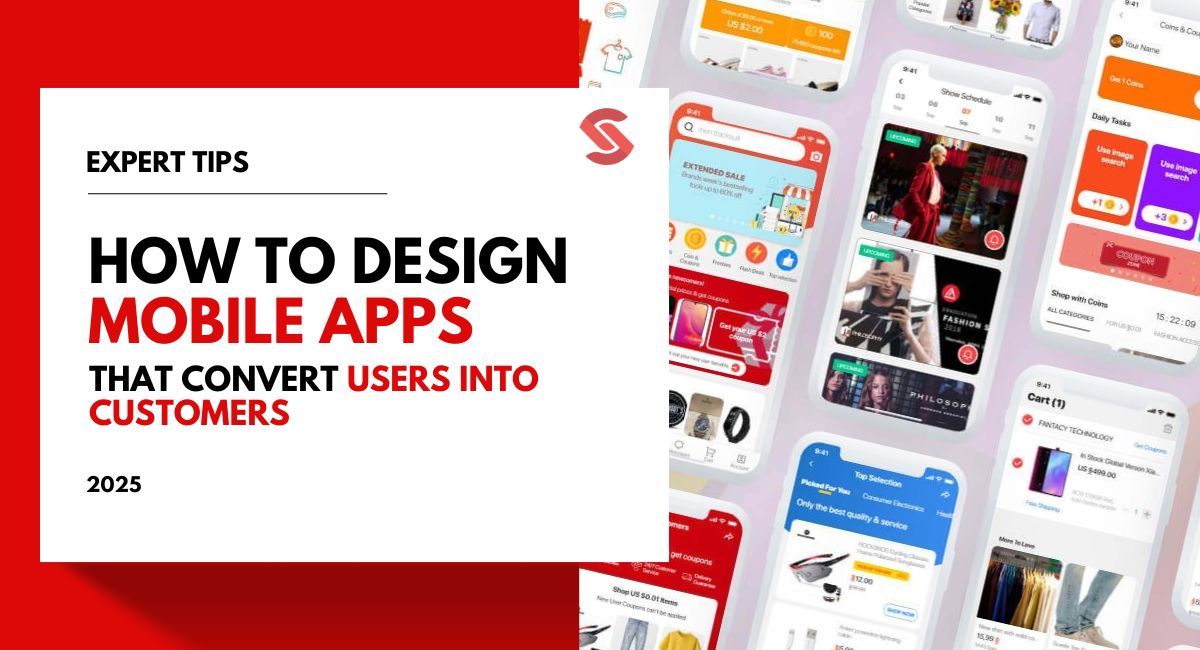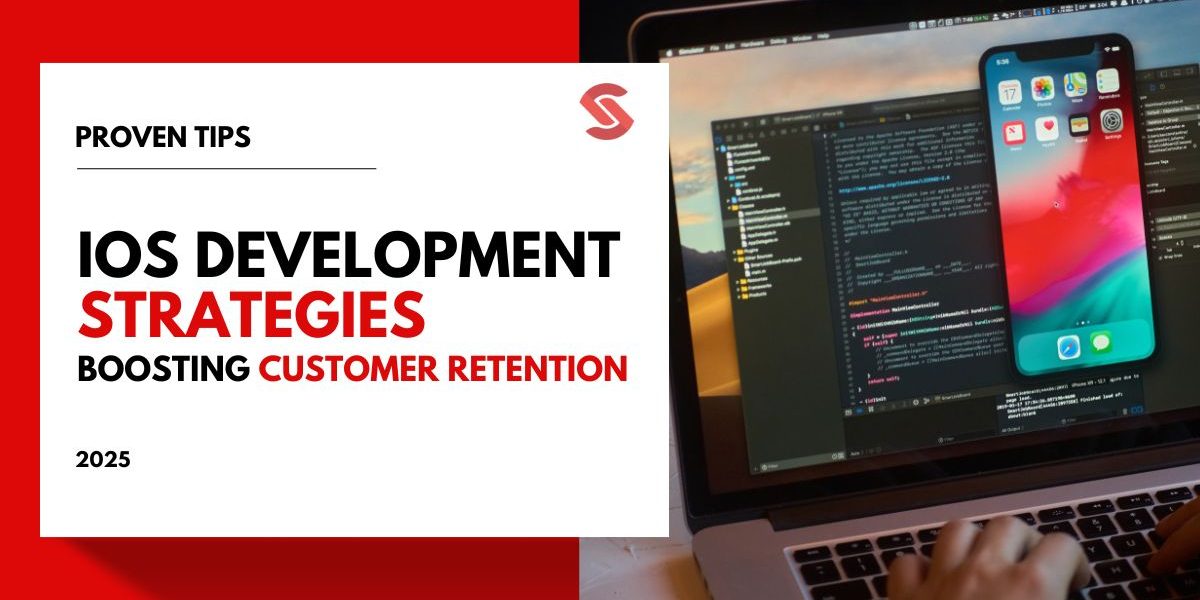Are you struggling to turn your mobile app users into paying customers? You’re not alone. As the mobile app market keeps changing, finding ways to create apps that guide users to the actions you want has become really important for success.
A recent study by Statista found that in 2024, over 90% of all internet traffic will be from mobile devices. This shows the huge potential for mobile apps to connect with customers. By making easy-to-use apps and using the power of mobile tech, businesses can find new ways to grow and boost their bottom line.
This blog post will explore the strategies and best practices that will help you design mobile apps that effectively turn users into loyal customers in 2025 and beyond.
Why Conversion-Focused Mobile App Design is Key in 2025
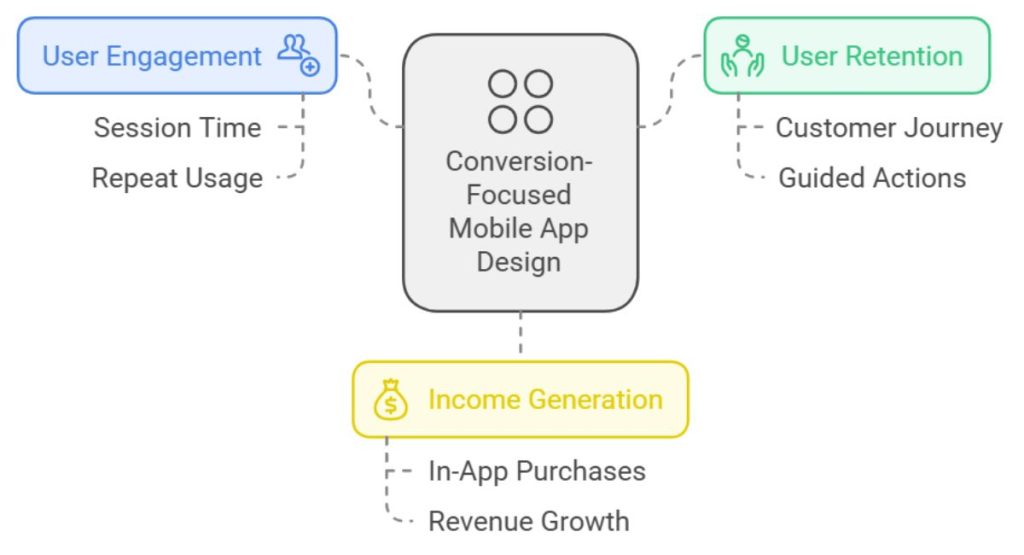
While it may seem obvious, the truth is that designing mobile apps with a strong focus on converting users is absolutely crucial for success in 2025. As the competition for user attention and loyalty intensifies, apps for business success are those that seamlessly guide customers through their journey and drive the desired actions.
Businesses can get a triple advantage by targeting conversion in app design, which will increase user engagement, retention, and income. Conversion-focused design directly impacts key metrics like session time, repeat usage, and in-app purchases, making it a smart, strategic investment for mobile-first companies looking to stay ahead in the evolving app market.
with Softnix!
Key Principles of High-Converting Mobile App Design
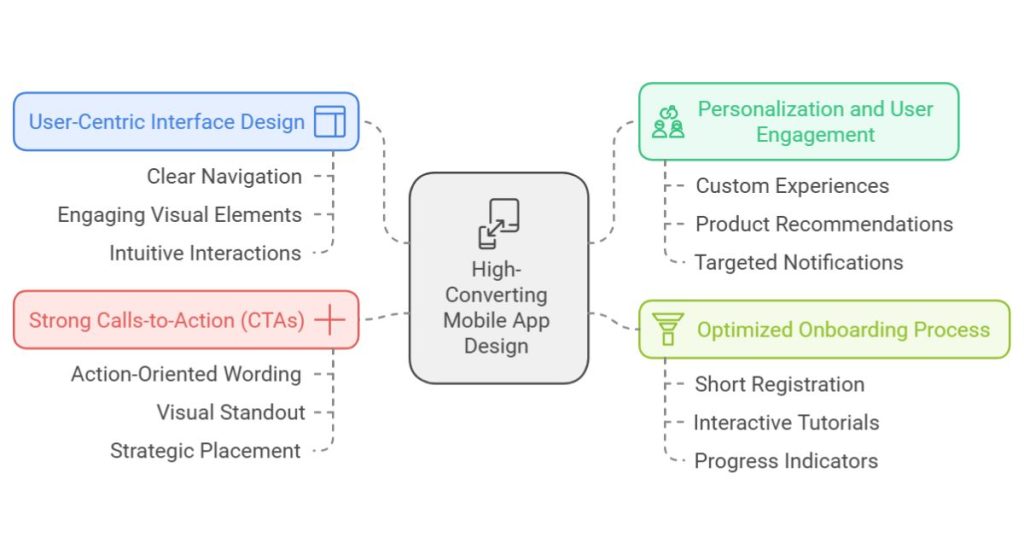
First impressions matter, especially in mobile app design, where user-friendliness and a seamless experience are key. A clean, minimalist interface, intuitive navigation, and quick loading times keep users engaged from the get-go.
Personal touches like tailored recommendations and clear, strategically placed call-to-action buttons drive interaction. Consistent design and accessibility options, like text resizing, make the app welcoming and easy for everyone to use.
1. User-Centric Interface Design
As Steve Jobs once said “Design isn’t just what it looks like and feels like. Design is how it works.” A user-centric interface focuses on crafting a smooth experience where every interaction feels intuitive, natural, and satisfying. It starts with clear navigation, enabling users to move through the app with ease and confidence.
Visual elements should be engaging yet straightforward, guiding users without overwhelming them. By prioritizing a user-first approach, mobile app UX becomes more than just functional; it becomes enjoyable and accessible. When users find an app easy to use from the first tap, they’re more likely to return and engage longer, ultimately creating a positive and lasting impression.
2. Personalization and User Engagement
One of the best ways to boost engagement and conversions in your mobile app is through personalization. By using insights about your users, you can create custom experiences that cater to each person’s needs and preferences. This could mean showing them product recommendations they will love, giving them personalized content, or sending them targeted notifications at just the right time.
The benefits of this personalized approach are clear:
- Stronger User Loyalty: When users feel an app understands and caters to them, they’re more likely to keep coming back.
- Increased Engagement: Features like custom recommendations encourage users to explore more of your app’s offerings.
- Enhanced User Experience: Apps that feel tailored to each user are more satisfying to use, and keep people engaged for longer.
- Improved Conversions: Content and calls-to-action that are personalized are more likely to get users to take the actions you want.
3. Optimized Onboarding Process
A smooth onboarding process sets the tone for a great user experience, helping new users quickly understand the app’s features without feeling overwhelmed. Effective onboarding should be quick and user-friendly, often including a short registration, interactive tutorials, and progress indicators to keep users engaged and informed.
By keeping the setup simple and intuitive, with options to skip or revisit steps, apps create a welcoming environment. This approach not only makes a strong first impression but also encourages users to confidently explore the app’s full functionality, increasing long-term engagement and satisfaction.
4. Strong Calls-to-Action (CTAs)
Clear and compelling calls-to-action (CTAs) are essential for guiding users toward key actions and boosting engagement. A well-designed CTA uses action-oriented wording and stands out visually, making it easy for users to notice and act on. Placing CTAs strategically where users naturally pause or complete tasks can increase conversions significantly.
In fact, according to a study by HubSpot personalized CTAs have been shown to convert 202% better than generic ones, highlighting how targeted, thoughtful design can drive user actions effectively. By focusing on clarity, placement, and design, apps can create CTAs that not only encourage clicks but also enhance the overall user experience, leading to more engaged and satisfied users.
Essential Features for Conversion-Optimized Mobile Apps
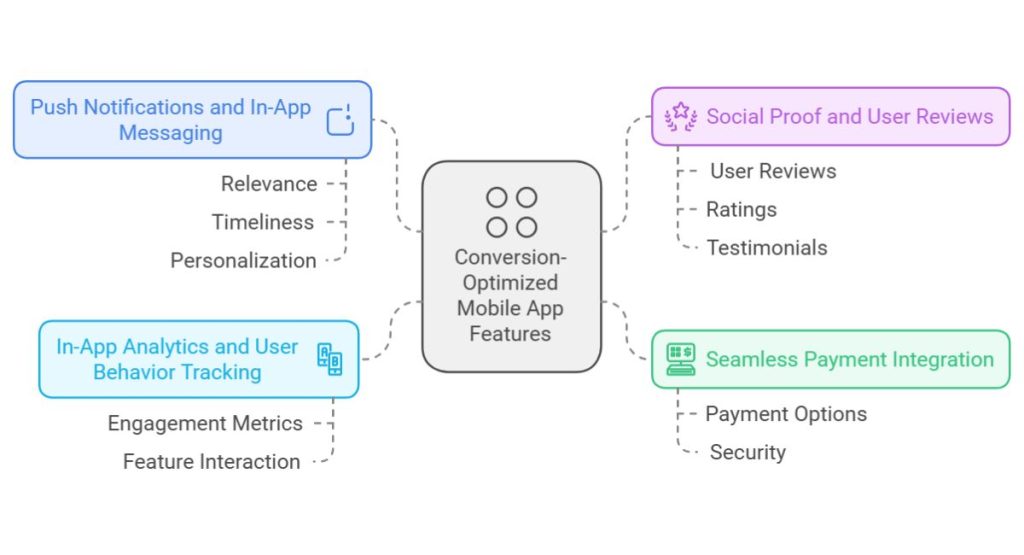
First things first a mobile app that’s optimized for conversions needs to prioritize user experience at every step. Start with a smooth onboarding process to help new users get acquainted, and use targeted push notifications to keep them engaged.
Secure payment options, quick load times, and offline functionality build trust. Social media integration simplifies logins and sharing, while in-app analytics offer insights for continuous improvement. Together, these features create a seamless experience that boosts conversions.
1. Seamless Payment Integration
For your mobile app to make money, the payment process has to be really easy and secure. Offer lots of different payment options, from one-click buying to digital wallets, so customers can check out quickly. Using trusted payment providers also helps build trust and stops people from abandoning their carts.
By simplifying the whole checkout experience, you’ll get more people actually completing their purchases. Getting the payment part right is key to turning your app users into paying customers. Make it simple and safe, and you will get much more revenue for your business.
2. Push Notifications and In-App Messaging
Push notifications and in-app messaging are powerful tools for keeping users engaged, reminding them of updates, and promoting special offers. For maximum impact, notifications should be relevant, timely, and personalized. By investing in app development services, you can ensure these features are seamlessly integrated, enhancing the user experience without feeling intrusive and encouraging users to stay active and explore more features within the app.
Benefits of Push Notifications and In-App Messaging:
- Customization: Personalizes messages based on user behavior, making them more relevant.
- User Re-engagement: Encourages returning to the app through reminders and promotions.
- Promotional Offers: Drives conversions by notifying users of special deals and discounts.
- Activity Reminders: Gently nudges users to complete actions or check new content.
- Timely Updates: Keeps users informed about new features, updates, or content.
3. In-App Analytics and User Behavior Tracking
In-app analytics and user behavior tracking are essential for creating an app that truly meets user needs. By analyzing engagement metrics, developers gain insights into how users interact with features, identifying areas for improvement and optimization.
This data-driven approach allows for A/B testing and refining of app elements to enhance the overall user experience. According to Mixpanel the apps that continuously optimize based on user data can increase engagement by up to 60%, highlighting the impact of informed design changes
4. Social Proof and User Reviews
Seeing is believing! that’s the power of social proof in mobile apps. Features like user reviews, ratings, and testimonials build trust by showcasing real experiences from other users. Positive feedback and high ratings strongly influence potential users’ decisions, making them more likely to engage and convert.
Customer feedback and user-generated content foster authenticity and transparency. Displaying recent reviews and easy-to-access ratings builds credibility, making users feel part of a trusted community. This trust encourages not only higher conversions but also long-term loyalty, as users feel confident about their choice and are more likely to recommend the app to others.
Design Trends to Increase Conversions in 2025
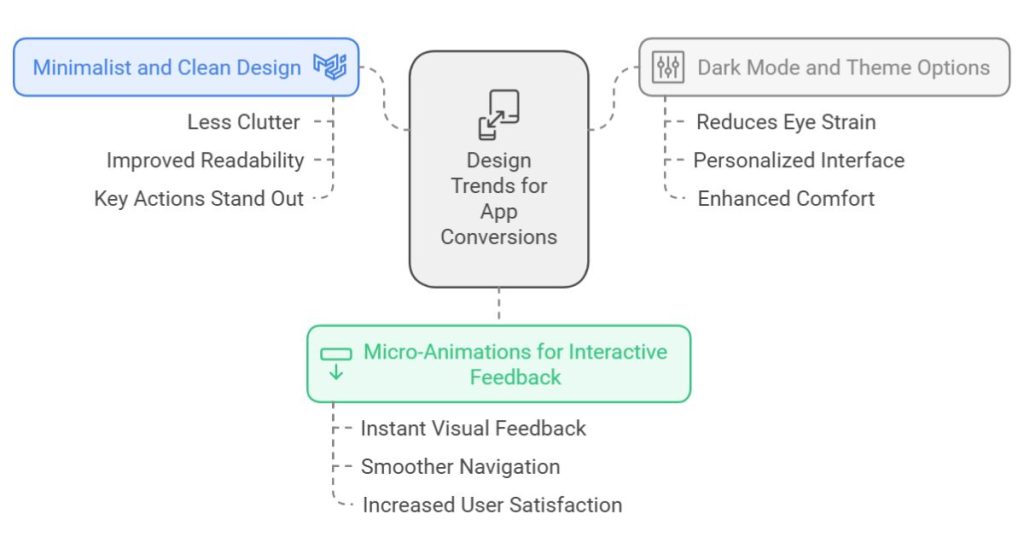
To boost conversions, modern app design emphasizes simplicity, personalization, and immersive experiences. Minimalist UIs keep actions clear and clutter-free, while voice user interfaces (VUI) provide hands-free navigation.
Eye-catching 3D visuals and engaging micro-interactions enhance usability, and dark mode offers a user-friendly option for reduced eye strain. Features like these show that investing in design pays off by using AI-driven personalization to tailor content to individual users. Meanwhile, augmented reality (AR) and a focus on accessibility make apps more inclusive and interactive.
1. Minimalist and Clean Design
Less is more when it comes to app design, and a minimalist, clean layout helps users focus on what matters most. By removing clutter, apps can prioritize readability and make key actions stand out. Simple layouts with clean visuals and readable fonts create a distraction-free environment.
With the support of UI/UX design services, this streamlined approach guides users smoothly through the app. This focused design not only improves usability but also creates a more enjoyable experience, making it easier for users to navigate, interact, and ultimately engage with the app’s core features.
2. Dark Mode and Theme Options
Design that adapts to you is the idea behind dark mode and theme customization in apps. By offering users control over visual settings, apps can enhance comfort and create a more engaging experience. Dark mode reduces eye strain in low-light environments, while theme options let users personalize the interface, making it feel uniquely theirs.
Few benefits of dark mode and theme options:
- Personalization: Allows users to choose a theme that suits their style.
- Reduced Eye Strain: Gentle on the eyes, especially in low light.
- Battery Efficiency: Dark mode saves power on OLED screens.
- Modern Look: Adds a sleek, contemporary feel to the app.
3. Micro-Animations for Interactive Feedback
Small touches make a big difference that’s the role of micro-animations in app design. These subtle animations provide instant visual feedback, letting users know their actions are recognized, which makes navigation smoother and more intuitive.
Micro-animations can guide users, highlight important elements, and add a touch of playfulness to the experience, making the app feel more interactive and enjoyable. According to the Nielsen Norman Group, micro-animations improve usability by creating a more natural and responsive interaction flow, enhancing overall user satisfaction.
How to Use A/B Testing to Refine App Design for Conversions
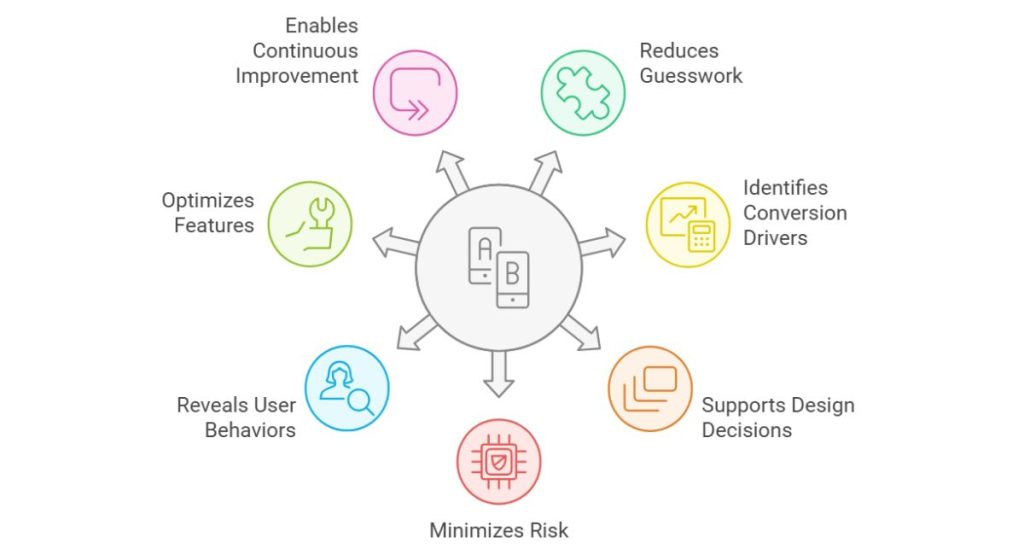
Testing makes perfect when it comes to app design for conversions. A/B testing is a powerful method for optimizing app elements by comparing two versions of a feature to see which performs better.
By experimenting with different layouts, colors, buttons, or content, developers can understand user preferences and make data-driven improvements. This split testing approach boosts conversion rates by ensuring every change enhances the user experience.
Benefits of A/B Testing in App Design:
- Reduces guesswork by providing clear data on what users prefer
- Helps identify design elements that drive more conversions
- Provides concrete evidence to support design decisions
- Minimizes risk when making major design changes
- Reveals unexpected user behaviors and preferences
- Helps optimize specific features for different user segments
- Allows for continuous improvement based on real user feedback
Conclusion
To design a mobile app that converts, focus on user-centered design, essential features, and upcoming trends for 2025. Prioritize easy navigation, accessible design, and clear calls-to-action that guide users smoothly through the app. Keep refining to match evolving user needs and industry standards.
Incorporate actionable insights for ongoing improvements, such as A/B testing, analytics-driven updates, and regular feedback loops. This approach ensures your app remains relevant, engaging, and effective at converting users over time.
For a trusted partner in high-conversion app design, Softnix is your go-to. Our expert team specializes in designing user-focused, conversion-optimized apps, with mobile app design services tailored to meet your business goals. With a data-driven approach and commitment to client success, Softnix builds apps that engage users and drive real results.
FAQs about High Conversion Mobile Apps Design
What features make a mobile app more likely to convert users?
Features like intuitive navigation, clear calls-to-action (CTAs), personalized content, and smooth payment options help convert users. Push notifications, easy onboarding, and fast loading times keep users engaged and encourage them to complete actions, ultimately boosting conversion rates.
How does user experience (UX) impact app conversions?
Good UX makes the app easy and enjoyable to use, keeping users engaged. When users find the app visually appealing and straightforward, they’re more likely to return and complete actions, resulting in higher conversions. Frustrating UX, on the other hand, can lead to drop-offs.
What is the best way to improve mobile app retention rates?
Personalization, timely push notifications, and user-centered design boost retention. By focusing on these areas, offering updates, and addressing user needs through data-driven insights, you can create a memorable app experience that keeps users coming back.
How important is personalization in mobile apps?
Personalization is key to user engagement. Tailoring content and recommendations to each user’s preferences makes them feel valued, which increases engagement, loyalty, and conversions. Apps that personalize effectively often see higher user satisfaction and retention.
What are the latest design trends for mobile apps in 2025?
In 2025, mobile app design trends focus on minimalism, dark mode, micro-animations, and augmented reality. Personalization and accessibility remain central, while AI-driven experiences and 3D visuals make apps more interactive, engaging, and user-friendly.
How can I reduce app churn rates?
To reduce churn, improve onboarding, personalize user experiences, and offer regular value through updates. Addressing user feedback, providing useful notifications, and maintaining a smooth UX also helps retain users and encourages long-term engagement.
What is an effective onboarding process for mobile apps?
An effective onboarding process is simple, interactive, and informative. Start with a brief tutorial or overview that highlights essential features, allowing users to explore freely. Offering skip options and progress indicators helps users feel comfortable and stay engaged.
How do push notifications increase app engagement?
Push notifications remind users about app updates, promotions, or new content, prompting them to return. By making notifications relevant and timely, apps can re-engage users without being intrusive, increasing engagement and overall app usage.
What are common mistakes in mobile app design that hurt conversions?
Cluttered interfaces, slow load times, confusing navigation, and poor CTAs often reduce conversions. Not optimizing for mobile-specific UX or ignoring user feedback can also lead to frustrating experiences, causing users to drop off.
What role do A/B tests play in app design?
A/B testing allows developers to compare different design elements, like CTAs, colors, or layouts, to see which performs better. This data-driven approach helps optimize features for conversions and ensures that design choices align with user preferences.
How can I use data to improve app conversions?
Data reveals user behaviors, such as which features they engage with or where they drop off. By analyzing these insights, you can optimize app elements, update features, and tailor experiences to boost conversions and better meet user needs.
Is dark mode important for user satisfaction in apps?
Yes, dark mode enhances user comfort by reducing eye strain, especially in low-light settings. Users appreciate having visual options, and it also adds a modern feel, making dark mode an increasingly popular feature for app satisfaction.
What are the most effective CTAs for mobile apps?
Effective CTAs are clear, action-oriented, and visually distinct. Phrases like “Get Started,” “Explore More,” or “Try Now” encourage action. Placing CTAs strategically throughout the app and making them easy to spot helps boost conversions.
How do micro-animations improve app user experience?
Micro-animations give instant feedback, guiding users and making navigation smoother. They add a playful element without distracting, creating a more interactive and engaging experience that encourages users to explore the app further.
What makes Softnix a top choice for mobile app development?
Softnix combines expertise in user-centered, conversion-focused design with a commitment to client success. Our team uses data-driven insights to craft custom apps that drive engagement and results, making us a trusted partner for high-converting app development.

